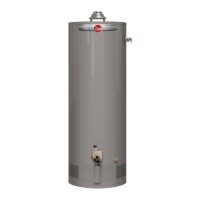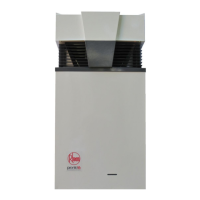12
Installing the water heater.
The water heater must be installed with the factory supplied draft hood in place.
Insulation Blankets
Venting
This water heater is a Category I -Natural Draft
appliance. Vent connectors must be attached to the
draft hood outlet to connect the water heater to the
gas vent or chimney. The vent connectors must be the
same size (diameter) as the draft hood or larger, never
smaller.
When an existing Category I appliance is removed
or replaced, the original venting system may
no longer be sized to properly vent the attached
appliances. Instructions shall also indicate effects of
an improperly sized venting system (formation of
condensate, leakage, spillage, etc.)
For proper venting in certain installations a larger
vent connector size may be needed. Consult the Vent
Tables in Appendix G of the latest version of the
National Fuel Gas Code (ANSI standard Z223.1 or
NFPA 54).
Multi-story and common venting is permitted in
accordance with the National Fuel Gas Code, ANSI
Z223.1/NFPA 54, and/or the Natural Gas and Propane
Installation Code, CSA B149.1, (current editions).
IMPORTANT: Multi-story and common venting is
NOT permitted for direct vent water heaters, water
heaters for installation in manufactured homes (mobile
homes), water heaters for installation in recreational
vehicles, or water heaters for outdoor installation.
Horizontal vent connectors must be pitched upward
to the chimney at least 1/4” per foot of length. Single
wall vent connectors must be at least 6” from adjacent
unprotected combustible surface. Vent joints must
be securely fastened by sheet metal screws or other
approved method.
In applicable climates, perodically inspect the vent
terminal to ensure it is not blocked by snow.
Test for spillage at the draft hood relief opening
after 5 minutes of main burner operation. Use a
flame of a match or candle or smoke. The flame or
smoke should be pulled into the draft hood’s relief
opening(s).
Insulation blankets, available to the general public, for
external use on gas water heaters are not necessary.
The purpose of an insulation blanket is to reduce
the standby heat loss encountered with storage
tank heaters. This water heater meets or exceeds
the National Appliance Energy Conservation Act
standards with respect to insulation and standby
loss requirements making an insulation blanket
unnecessary.
The manufacturer’s warranty does not cover any
damage or defect caused by installation, attachment
or use of
any type of energy saving or other unapproved
devices (other than those authorized by the
manufacturer) into, onto or in conjunction with the
water heater. The use of unauthorized energy saving
devices may shorten the life of the water heater and
may endanger life and property.
The manufacturer disclaims any responsibility for
such loss or injury resulting from the use of such
unauthorized devices.
CAUTION: If local codes require the
application of an external insulation blanket to this
water heater, pay careful attention to the following
so as not to restrict the proper function and
operation of the water heater:
● DO NOT cover the operating or warning labels
attached to the water heater or attempt to relocate
them on the exterior of insulation blanket.
DO NOT apply insulation to the top of the water
heater. This will interfere with the safe operation of
the draft hood.
DO NOT cover the burner access door, jacket
door, gas control (thermostat)/gas valve or pressure
and temperature relief valve.
DO NOT apply insulation to the bottom of the
water heater or the area where the combustion
air inlet openings are located. This area must be
unobstructed so as not to restrict combustion air
flow to the burner.
Inspect the insulation blanket frequently making
certain it has not sagged and is restricting the
air flow to the combustion air inlet openings
(perforation holes) located around the lower
perimeter of the water heater jacket. This could
result in an unsafe operating condition.
DANGER: Failure
to install the draft
hood and properly
vent the water heater
to the outdoors as
outlined in the
Venting section of this
manual will result in
unsafe operation of
the water heater
causing bodily injury,
explosion, fire or
death. To avoid the
risk of fire, explosion,
or asphyxiation from
carbon monoxide,
NEVER operate the
water heater unless it
is properly vented
and has adequate air
supply for proper
operation as outlined
in the Venting section
of this manual.
WARNING: If
local codes require
external application
of insulation blanket
kits the
manufacturer’s
instructions included
with the kit must be
carefully followed.
Heat Traps
For increased energy efficiency, some water heaters
have been supplied with factory installed 3/4” NPT
heat traps in the hot outlet line and cold water inlet
line.
These heat traps may require a minimum of one (1)
90° 3/4” NPT elbow and may require an additional
90° 3/4” NPT elbow or a 3/4” coupling depending
on your installation needs. See Illustration of nipples
and heat traps on page 23.

